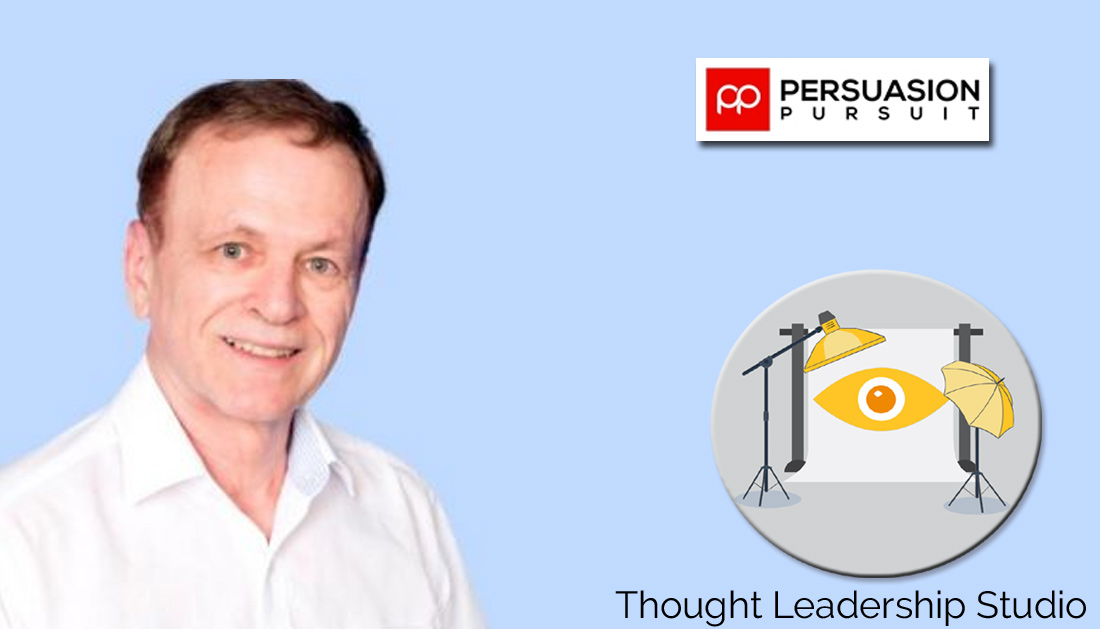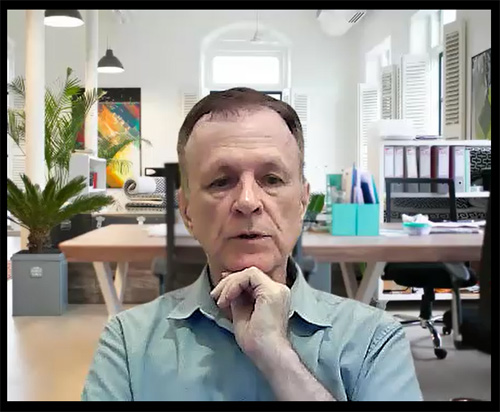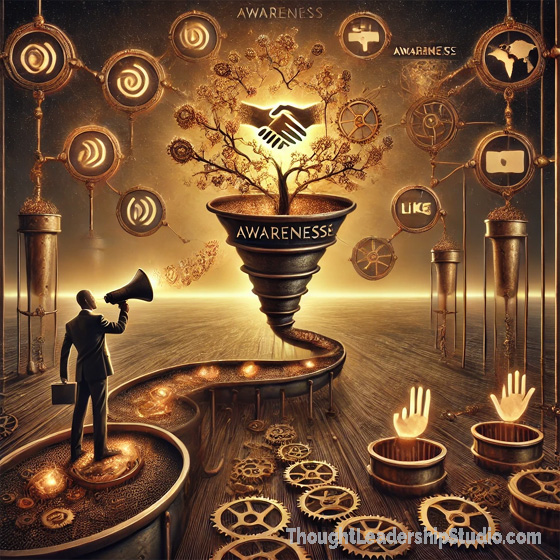Thought Leadership Studio Podcast Episodes:
Kim Willis on LinkedIn Mastery
Episode 85 – From Door-to-Door Sales to Digital Influence: Kim Willis on Building Authority, Relationships, and Business Growth through Content Strategy

#consulting, #contentmarketing, #digitalnomads, #entrepreneurship, #influence, #influencermarketing, #interview, #leadership, #marketing, #marketingstrategy, #networking, #personalbranding, #persuasion, #sales, #socialmedia, #storytelling, #thoughtleadership, #thoughtleadershipmarketing, #writing
Or Click here to listen or subscribe on appWhat this episode will do for you
:- Kim Willis' Journey from Traditional to Digital Sales: Explore how Kim transitioned from door-to-door sales to mastering affiliate marketing and LinkedIn strategies.
- The “Relax, Disturb, Relieve, Close” Framework: Discover Kim’s powerful approach to storytelling and sales, emphasizing customer needs and ethical influence.
- Overcoming the Myth of Content-Only Success: Understand why relationships matter more than just posting content, and how to nurture prospects effectively online.
- Building Authority on LinkedIn: Learn practical tips for optimizing your LinkedIn profile, creating meaningful content, and using engagement to build trust.
- Nurturing Long-Term Business Relationships: Gain insights into Kim’s strategy of cultivating prospects at the top of the funnel through authentic connection and ongoing engagement.
Kim Willis
In this episode, I’m excited to introduce Kim Willis, founder of Persuasion Pursuit and expert in direct response marketing.
Kim’s journey from door-to-door sales to online content strategy demonstrates that while technology changes, the fundamentals of human connection stay the same. With mastery on LinkedIn, he shares how authentic content and relationship-building drive meaningful business growth.
LinkedIn is a primary platform for Strategic Thought Leadership and Kim's wisdom and knowledge of the platform can help all of us who aim to positively influence and lead people to fresh perspectives in the business world using this social media channel.
We explore his “relax, disturb, relieve, close” framework and discuss the myth of content-only success. Kim offers practical tips on nurturing prospects at the top of the funnel, engaging meaningfully through DMs, and optimizing LinkedIn profiles to build trust and authority.
This conversation is packed with actionable insights on turning strategic content into lasting business relationships.
Some of Kim's coordinates:
Curated Transcript of Interview with Kim Willis
The following partial transcript is lightly edited for clarity - the full interview is on audio. Click here to listen.
Chris McNeil: I'm Chris McNeil, with Thought Leadership Studio, and today I am thrilled to be speaking with Kim Willis, founder of Persuasion Pursuit and leading authority in direct response marketing.
Over the years, Kim has helped countless entrepreneurs unlock their potential through high-conversion copywriting and strategic list building, generating millions in revenue.
He has also cracked the code on LinkedIn, turning it into a powerful platform for building relationships and driving sales. His unique blend of traditional sales psychology with modern digital strategies has made him a highly sought -after mentor. Welcome, Kim. It' s great to have you here.
 Kim Willis: Hey, Chris. Thanks very much for the invitation. Looking forward to it.
Kim Willis: Hey, Chris. Thanks very much for the invitation. Looking forward to it.
Chris McNeil: Yes, and to the listener, we're acquainted. We've been in touch now for over a year. We've been there, and I wanted to have Kim on the podcast for a while, largely because he has, as I mentioned, cracked the code on LinkedIn. But, Kim, you used to be a brick -and -mortar salesperson. Is that correct?
Unlocking Sales Potential: The Role of Storytelling and Questioning
Kim Willis: Yeah, we used to call it belly-to-belly. That' s right. So, originally, I started as a door -to -door salesman. I think I was age 18. I didn't do very well with that, but I learned a fantastic lesson – or two lessons. One was to do with asking questions and listening closely to the answer or the answers, and then interpreting those answers.
So, that was the first major skill. It’s more than a sales skill. I think it’s a communication skill. That was the first one. But the second one was regarding storytelling. And after failing, I did an in-house training with them, and I was trained by the number one salesman in the world for this particular product. It was a book. It was called Modern Ways to Health', the two-volume item, two-volume product. I can’t remember what it sold for. It was definitely less than $100 in the money of that time.
And then he said, 'Okay, well, you go out on Monday morning, you just knock on doors, and then you check in on Friday.' Okay. So. That was it. Just throw them under the walls. And all right. So, knock on a lot of doors and get a lot of no's. I got into a few houses. At least I was able to give a presentation each day that I went out.
But by Friday, it was zero. Nothing. Except despondency and strong feelings that I want to quit. So, anyway, I kept my word. I phoned in to the sales manager. And he said, 'Okay, all right. I want you to quit, please. Let's just try one more week. But this time, I'll come out with you next Monday morning. We made arrangements. And so, I met him. And we started knocking on doors. Well, I started knocking on doors. He was just standing back and watching.
And after about 15 minutes, I got into the first house. Sat down. And, you know, a little bit of chit-chat. And then I started doing the presentation again. And once again, I bombed. So, out we go. And he said, don't worry. We'll knock on some more doors. See if we can get into another house. And see what happens there.
 So, yeah. Sure enough, after, I don't know, 20 minutes, half an hour, whatever it was, I got into another house and sat down, did the same presentation, more or less. And once again, I bombed. So by this stage, I was kind of mortified because the number one seller in the world was watching me.
So, yeah. Sure enough, after, I don't know, 20 minutes, half an hour, whatever it was, I got into another house and sat down, did the same presentation, more or less. And once again, I bombed. So by this stage, I was kind of mortified because the number one seller in the world was watching me.
So, even the books originated from the U.S. I' m from Australia. So, he was even beating the impossible. He was beating the Americans at doing it. That’s how good he was. And his name is Stan Rex. And so, I started walking. He said, 'Look, I think we might jump in the car and go and have a cup of coffee or orange juice or something like that.' And we'll do a bit of a debrief because I don’t want to put you through any more agony until we sort this problem out.
So, that's When we sat down and he said, ' Okay, I want you to just think about what you’ve been doing. And then think back to the formal training that we gave you the week before. Was there anything there that you could see that you were not doing compared to what you learned at the in-house formal training?' And after a minute or so, I thought, 'Well, I probably didn’t ask many questions or sometimes I didn’t ask any.' And he said, 'Yeah, that’s true.'
And why was that? Why were you hesitant about asking questions? Fear? I couldn’t. I just thought of, you know, how do I do this? Push back from the prospect, the fear of silence, you know, what if they take a minute before they answer? So, he said, 'Yeah, yeah, that’s perceptive of you. 'But there's one other thing that you didn’t do that you were taught. He said, 'You didn’t tell any stories.' I said, 'Oh, yeah, yeah.' It must have been just nerves. When I was doing it by myself last week, I told a few stories. But I don’t think I was that good at it.
He said, 'Well, whatever, whether you did them or you didn’t do them, obviously, something's not working there.' Because if you get the questioning right and you get the storytelling right, you just normally just sail through to an easy close, you know, no problems at all. So, that was it.
So, I thanked him and then I went back the next day and started knocking on doors again. I didn’t make any sales that day. But I think two days later, I did make my first sale. And either later that day, I made another sale and then made several more sales after that.
But two or three weeks later, I made the decision that I'm really not cut out for door-to- door. But I was happy that at least I made some sales, I got paid the commission, and I learned two valuable skills. That was it.
And from there, I went into the financial services industry selling life insurance. Oh, my God, that’s like a whole different story. Change from that frying pan into the fire at first, but I did very well in that industry. So, 15 years in the industry, so that was great.
So, yeah, that's how I got started. But yeah, there's storytelling and asking questions and listening closely to the answers and then interpreting the answers and yeah, those two skills, I think, are so valuable. A lot of people don’t really acquire them.
The Psychology of Storytelling: Crafting Narratives That Lead to Sales
Chris McNeil: And you told a great story about telling stories. And you’re clearly skilled at that. I noticed the components of the hero's journey in there even of the mentor and the growth experience and getting out of your comfort zone and coming back with new skills to take to another environment.
To you, what are the components of a story that truly engage an audience and leads them to where you want to take them?
Kim Willis: Yeah, that’s a great question. Normally, I like to lead with pain, so we’ve got to be comfortable with that. And a lot of people in sales and marketing, especially if they’re experts, they come from more of a technical background, not so much a sales background. Could be accountants, could be bookkeepers, consultants, CFOs, COOs. Yeah. CTOs, fractional CTOs that worked in the company for a long time. They learnt all of the processes and the methodologies, but they didn’t have to find their own clients, but they decided to go out on their own. Maybe they got entrenched or something like that.
 Then it’s moment of truth time and they realize that there’s a great skill set that they don’t have. There’s a significant skill set that they don’t have. And that’s why sometimes people reach out to me because they recognize there’s a gap there and they need some help. It’s difficult to bridge the gap. But leading with pain is definitely a big part of it, I think. In fact, one of my teachers in the life insurance industry, who was an incredible teacher. I had two great teachers, the first one when I was age 22 and the next one came along seven years later, age 29. And the second guy, he taught me the power of the disturbing people. This is in, once again, in belly-to- belly, face-to- face situations.
Then it’s moment of truth time and they realize that there’s a great skill set that they don’t have. There’s a significant skill set that they don’t have. And that’s why sometimes people reach out to me because they recognize there’s a gap there and they need some help. It’s difficult to bridge the gap. But leading with pain is definitely a big part of it, I think. In fact, one of my teachers in the life insurance industry, who was an incredible teacher. I had two great teachers, the first one when I was age 22 and the next one came along seven years later, age 29. And the second guy, he taught me the power of the disturbing people. This is in, once again, in belly-to- belly, face-to- face situations.
And so the lessons that I learned from him, they drove deep into my psyche, if you like. And so I never forgot those lessons. They’re so powerful. My income doubled, tripled. Travelled, quadrupled within 90 days. And relax, disturb, relieve, close was the little formula he taught me. So you relax, let people, then you disturb them and then give them some conceptual relief in a conceptual form. And then show them specifics of the solution if they want to, if they’re hot to trot for it. And then you can just do a simple close. There’s no big hard sell or anything like that.
If you get the front part right, that’s what he always said. If you get the, you know, the middle part, you know, the middle part, you know, the middle part, the fear thing, the disturbed, disturbing people, making them feel a bit uncomfortable. You don’t need to be a hard closer. It’ll just, you know, it’ll happen naturally. So when I finally made the transition to the online world, starting in 2006 as a high ticket affiliate marketer, I once again brought on board these skills.
The Myth of Content-Only Success: Combining Media with Connection
So, my mentor taught me how to use Google AdWords to generate leads online. And then they’d go to a capture page. And there’d be a phone field. And if they filled in the phone field, I’d call them. And once again, I just brought to the fore these, these skills of asking questions, finding out what the pain is, pressing the pain button a little bit in an ethical way. And yeah, and telling stories. So, so yeah, that was it. And, and, and I started making sales in the online affiliate marketing kind of thing, although making phone calls is obviously an offline traditional activity, but eventually it became a Skype thing where I was using Skype and when I was traveling, doing a lot of overseas traveling, all of that.
But still, once again, the same skill sets that I acquired previous years, people, previous experiences with great teachers served me, served me very well. And then, then when I made the next transition in the online world to content. Content. Social media in particular, starting with Facebook in 2016, and then more recently LinkedIn in 2021. So it’s not that long ago. It was, I knew by then that content was the deal and there’s not, there So no more face-to- face, belly-to- belly stuff here. We’re talking about content to kind of woo people to demonstrate competence and build some authority. Hopefully. So it became obvious to me that it’s imperative to win the content game. It’s absolutely imperative. Otherwise you’re just going to you’re just not going to make progress.
You’re going to be frustrated. Then you’ll start blaming the platform. You mentioned LinkedIn, but it could be Facebook, it could be something else, but we start blaming the platform. It’s amazing. And I, when I, when I started with transitioning across, it was just after COVID. Yeah. It ceased to be a major problem.
I started transitioning to LinkedIn and I did make some connections with some interesting people and, and good people. And there were some people there that I thought were hot influencers, getting hundreds of comments every time they post; all of this really shocked me three or four months later, when two of them, people that I’ve had just nice conversations with, within the DMS, two of them quit and they quit posting every day. And I thought, what’s happening here?
So I reached, I still had a LinkedIn account, but I reached, I reached out to one of them. I said, I haven’t seen you posting recently. And they said, well, I’ve gone back to a day job, big influences. They weren’t getting any business. They weren’t making any money. And that, that was one of them. And the other one actually came clean in a post. And he said, ‘Look, I’m having to take up a job.’I really hate that. My dream has been shattered, you know, create independence, digital nomad thing, working from home, whatever. At least he was, you know, straight up front about it.
But you, you meant you alluded to the, the myth of the content only method. So yeah, the first 12 months I didn’t get any inbound leads from my content and I would rate my content as above average, well above average. Compared to most of the content that we see in our newsfeed, it is, you know, I do write content that speaks to pain or speaks to problems, et cetera, and then shows, gives people an idea as to how to maybe solve that little problem, et cetera. And I started to get some comments, which was nice, a little bit of social proof coming through there. A lot of posts don’t get much engagement at all. Visible public engagement.
 A lot of it has to do with their content. It’s just not good enough. So it doesn’t, it doesn’t speak to people on their terms, you know, it doesn’t, yeah, it doesn’t resonate with them. So they just keep scrolling, scrolling, scrolling, looking for something else that’ll, that’ll grab them, you know, so, but yeah, the, the, the content thing is, is vitally important. I think everybody needs to, if you, if you want to make, make one of these social platforms work for you, you’ve really got to sort out the content.
A lot of it has to do with their content. It’s just not good enough. So it doesn’t, it doesn’t speak to people on their terms, you know, it doesn’t, yeah, it doesn’t resonate with them. So they just keep scrolling, scrolling, scrolling, looking for something else that’ll, that’ll grab them, you know, so, but yeah, the, the, the content thing is, is vitally important. I think everybody needs to, if you, if you want to make, make one of these social platforms work for you, you’ve really got to sort out the content.
You have to put things in to some kind ... to get things out. But, and so that’s the addictive factor. To get things out. I'm looking for a group maybe to I can somebody relationship emotionally and have ... well, you may have one deal in a group, but you need to be talking to a lot of people but it’s very expensive. But since you can. re looking probably for without, yeah. One, you quickly get to a new online. You can let people get interested. I already said it, it’s like a going pay for your own online service. You can get into the other world, we’re all going to double down your business, right.
So keep into it, keep with the online and archive our, our profiles and all that stuff. you’ve got a few couple of other opportunities just below that, depending on the status of your account, and then we get to the about section and the about section gives you plenty of room to tell a good story. The question is, will it be a good story? Are you just going to talk about yourself all the time? Are you going to talk about them? That’s I think a lot.
I did a call earlier earlier uh with a lady and she is and she’s in Australia and uh I look at previous before I went under the call I had to look at her about section. She needed help and uh looked at her about section, it was just about her, you know me. It was like an a resume just a glorified resume. It doesn’t work not now it doesn’t work. So we’ve got to call out the pain, we’ve got to um uh, you know, lead with some kind of a problem that your ideal client is is is experiencing maybe you've got to call out the pain we’ve got to um uh you know lead with some kind of a problem that you might solve that problem conceptually speaking um you know there’s different ways we can structure the about section but if we get the about if we get the our personal profile working properly um that gives us a good uh yeah a good opportunity to get some action happening um but then we marry that with with uh appropriate content then that’s the between uh yeah they’re the two you know wins that ...
So, if you can get your um your personal profile looking good uh you get your news feed looking good uh plenty and you’re starting to get some comments and some engagement then when a prospective client checks you out, yeah you’re in a much better position absolutely.
The Shift from Selling to Serving: Nurturing Leads with Thoughtful Content
Chris McNeil: You've covered a lot of ground already, Kim.
Kim Willis: Thank you.
Chris McNeil: I want to give our listener a little bit of context and correct me anywhere I’m off, but you’re from Australia, but you’re living in Cambodia, which is not the best environment for face-to-face business, so you’ve really moved all your business online at this point ...
Kim Willis: Yeah.
Chris McNeil: ... and that's different for some of us who work with clients online and also have local clients. I’m in Charleston, South Carolina which is - you know - a medium-sized city with a healthy business environment but you don’t have that benefit.
So you’ve had to crack the code and to pick a thread I think would be interesting to dive into maybe a little more., you understand that in spite of all the tech tools that we have around us, which can be hypnotizing, it still comes down to human psychology: Human nature is human nature.
People respond to stories; they still respond to the same methods of persuasion that we went face-to-face. But the difference is now the typical way to do it is to do it face-to-face, and you know the typical sales process that we used to go through - generate leads somehow, follow-up of a series of phone calls, meetings or letters has largely been replaced by a self-serve process where people are consuming content.
And your content has to do a lot of that work for you and for them. And it shouldn’t be self-serving but should be about the person you’re writing to and their problems, and what they can do about them.
Kim Willis: Yeah, yeah, exactly. Um, a lot of the content that I see in in my news feed is what I call "love us content" so great, look at me, look at my boards, look at what’s yeah it s all about them oh look I’m at this networking event yes yes yes so what it’s um that’s that might impress people who are at the bottom of the sales funnel where they look actively looking for solutions now they’re looking for a provider uh but most of the time they’re looking for a people on LinkedIn are not actively looking for a solution they a lot of them do have a problem. but they’re not they’re kind of vaguely aware of a problem maybe they are experiencing some pain depending on what your niche is and who you’re targeting but um they’re not actively looking for a solution because they don’t know what to look for they’re not yet at that point.
 So we’re much better off if we’re creating content that caters to the people at the top of the funnel uh these are these are the pain aware people and the problem aware people that those those two groups they’re the most important ones that’s the bigger part of the market and uh the people who are actively looking for a solution will possibly it’s just too late for you if you haven’t already gotten a relationship with them it’s too late because they’ll have relationships with other people and so you’re: better off cultivating people a little bit earlier in the process, and you do it with this type of content.
So we’re much better off if we’re creating content that caters to the people at the top of the funnel uh these are these are the pain aware people and the problem aware people that those those two groups they’re the most important ones that’s the bigger part of the market and uh the people who are actively looking for a solution will possibly it’s just too late for you if you haven’t already gotten a relationship with them it’s too late because they’ll have relationships with other people and so you’re: better off cultivating people a little bit earlier in the process, and you do it with this type of content.
You build a phone like a classic content example. It’s nighttime my time as you know Chris, but this morning uh when I woke up, check- check my uh my emails and LinkedIn, and there’s a message from a lady who’s in New York City; I’m in New Jersey, New Jersey, and um she’s the lady that I’ve been connected with for about two years. She was already she was going to hire me about it uh like a year ago but she had a health crisis so we put her on the phone and she said m going to hire you, and I put everything on hold and uh, she was like out of action for many months, but she came back and I, I didn’t start hustling or anything like that, but I just said welcome back, you know, good to see that things have worked out for you. I didn’t even talk about business; she’s a really nice lady, I like her, and uh, you know, so I just left it at that.
Comment on her content once a week minimum and anyway, she reaches out and she leaves a voicemail saying, look, I keep looking at your content; see the content is important, it just it doesn’t always generate an inbound lead, but it kind of reinforces I already had a relationship with her, but my content kept reminding her of key issues and she said 'I’I just wondered if we could do another call. We haven’t done one since before I got sick, and then I’ve had a further discussion with her so now she’s yeah she she wants to do business. We’ve just got to work something out that’ll work for both of us, so um I’m talking to her tomorrow, so yeah it’s it’s marvelous when when you get it to that point where um you know the content is doing its bit, your personal profile is doing its bit and then if you’re engaging with people a little bit in the DMS.
I’m not talking about doing salesy things like that. It’s we don’t need to. We do it right build a relationship expose people to the content and then we If you’ve got a good piece of content that’s had some good support from your followers, and you think it might be relevant for that particular prospect, okay it’s okay to just send them a message and say ‘Hey Mary, I thought this might be relevant to you based on our previous discussion. And if you like my post that would be great if you could leave a comment that’s it and then sooner or later it starts to you know starts to work so the wheels start to turn and then someone like lady the this morning reached out to me and then you know away we go again so another little adventure begins absolutely answer the question.
***************************************
The transcript is lightly edited for clarity and is a partial transcript- the full interview is on audio. Click here to listen.
***************************************
Free Stuff and Offers Mentioned in Podcast
***************************************
***************************************